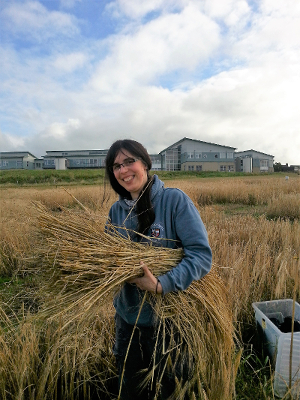Magdalena Blanz

Email: m.blanz.11@aberdeen.ac.uk
Website: https://www.researchgate.net/profile/Magdalena_Blanz
PhD Thesis title: Seaweed as food, fodder, and fertiliser: Methods of identification, impacts, and implications of past seaweed use in archaeology
Supervisors: Dr Ingrid Mainland (UHI Archaeology Institute), Dr Mark Taggart (UHI ERI), Dr Philippa Ascough (SUERC) and Prof Jörg Feldmann (TESLA, University of Aberdeen).
Magdalena undertook her PhD studies at Orkney Archaeology Institute from 2016-2020, researching past seaweed consumption, and the implications that seaweed consumption by sheep holds for our understanding of the past. As part of this, she researched how the chemical and isotopic composition of skeletal material changes with the consumption of seaweed in modern material, and analysed archaeological material, including sheep from the Ness of Brodgar, to identify past seaweed consumption. Magdalena also studied the effects of fertilising barley with seaweed in a field trial (pictured) in partnership with our Agronomy Institute and the James Hutton Institute in Dundee.
At UHI research conferences, Magdalena received prizes for the best poster by a postgraduate student (2016), and best student presentation (2017) for her work on identifying seaweed-consumption from skeletal remains. At the UK Archaeological Science Conference 2017, her poster on the identification of seaweed-eating by analysis of sheep’s teeth was awarded the first prize for a student poster, and her presentation on the effects of seaweed fertilisation on grain crops at the AEA 2018 conference in Denmark was awarded the best student presentation prize. Since finishing her PhD, Magdalena has started a Postdoc position at the University of Vienna.
In 2022, Magdalena and colleagues won the runner-up poster prize for early career researchers at the UK Archaeological Science conference in Aberdeen, Scotland.
In 2023, she was awarded the BAG-Förderpreis 2021 by the Austrian Society for Bioarchaeology (BAG) for her PhD dissertation, entitled Seaweed as food, fodder, and fertiliser: Methods of identification, impacts, and implications of past seaweed use in archaeology.
Research output:
Blanz, M., Ascough, P., Mainland, I., Martin, P., Taggart, M.A., Dieterich, B., Wishart, J., Sayle, K.L., Raab, A., Feldmann, J., 2019. Seaweed fertilisation impacts the chemical and isotopic composition of barley: Implications for analyses of archaeological skeletal remains. J. Archaeol. Sci. 104, 34–44. https://doi.org/10.1016/j.jas.2019.02.003
Blanz, M., Britton, K., Grant, K., Feldmann, J., 2018. Potential dietary, non-metabolic accumulation of arsenic (As) in seaweed-eating sheep’s teeth: Implications for archaeological studies. J. Archaeol. Sci. 94, 21–31. https://doi.org/10.1016/j.jas.2018.03.008
Blanz, M., Mainland, I., Richards, M., Balasse, M., Ascough, P., Wolfhagen, J., Taggart, M.A., Feldmann, J., 2020. Identifying seaweed consumption by sheep using isotope analysis of their bones and teeth: Modern reference δ13C and δ15N values and their archaeological implications. J. Archaeol. Sci. 118. https://doi.org/10.1016/j.jas.2020.105140
Brown, L.K., Blanz, M., Wishart, J., Dieterich, B., Schmidt, S.B., Russell, J., Martin, P., George, T.S., 2020. Is Bere barley specifically adapted to fertilisation with seaweed as a nutrient source? Nutr. Cycl. Agroecosystems. https://doi.org/10.1007/s10705-020-10090-w
Mainland, I., Blanz, M., Ayres, J., Webster, C., 2020. Cattle and other animals: Human-animal relationships at the Ness of Brodgar, in: Card, N., Edmonds, M., Mitchell, A. (Eds.), The Ness of Brodgar: As It Stands. The Orcadian, Kirkwall, pp. 266–277.
Blanz, M., Balasse, M., Card, N., Ascough, P., Fiorillo, D., Taggart, M.A., Feldmann, J., Mainland, I., Blanz, M., Balasse, M., Card, N., Ascough, P., 2022a. Life, Death and Teeth of Late Neolithic Sheep and Red Deer Excavated at Ness of Brodgar, Orkney Islands (UK). Environ. Archaeol. 1–13. https://doi.org/10.1080/14614103.2022.2146320
Blanz, M., Stewart, S., Mainland, I., Ascough, P., Raab, A., Feldmann, J., Taggart, M.A., 2022b. Trace element ratios in tooth enamel as palaeodietary indicators of seaweed consumption and coastal grazing, and their broader applicability. J. Archaeol. Sci. 139. https://doi.org/10.1016/j.jas.2022.105551
Magdalena’s PhD was funded by the European Social Fund and Scottish Funding Council as part of Developing Scotland’s Workforce in the Scotland 2014-2020 European Structural and Investment Fund Programme.
